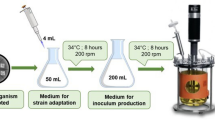Abstract
Cassava peel was readily degraded and utilized by a strain ofRhizopus growing in a solid-state fermentation. Growth was maximal at 45°C and was proportional to the degree of hydrolysis of the peel. The yield of biomass, as weight of dry mycellum from the reducing sugars of the peel, was 51%. After 72 h fermentation, the peel contained 76% moisture, 6% cellulose, 7% hemicellulose and 0.4% ash and the protein content had increased from 5.6% to 16%. These results suggest a possible economic value of cassava peel in the production of fungal biomass and feedstock.
Résumé
Les pelures de manioc sont aisément dégradées et utilisées par une souche deRhizopus croissant en milieu solide. La croissance est maximale à 45°C et est proportionnelle au degré d'hydrolyse des pelures. Le rendement en biomasse, en poids de mycelium sec à partir des sucres réducteurs des pelures, est de 51%. Après 72 heures de fermentation, les pelures contiennent 76% d'humidité, 6% de cellulose, 7% d'hémicelluloses et 0.4% de cendres. Le contenu en protéines augmente de 5.6 à 16%. Ces résultats suggèrent une valorisation potentielle économique des pelures de manloc dans la production de biomasse et de substrat longique.
Similar content being viewed by others
References
Association of Official Analytical Chemists (AOAC) 1975Official Methods of Analysis, 12th ed, pp. 12–25. Washington DC: AOAC.
Ben-Gera, I. &Kramer, A. 1969 The utilisation of food industries wastes.Advances in Food Research 17, 77–152.
Blanc, P., Faup, G.M. &Goma, G. 1987 Production of acetic proprionic acids from household refuse: enzymatic hydrolysate byPropionibacterium acidipropionic.Biomass 12, 49–52.
El-Masry, H.G. 1983 Utilisation of Egyptian rice straw production of cellulases and microbial protein: effect of various pre-treatments on yields of protein and enzyme activity.Journal of the Science of Food and Agriculture 34, 725–732.
Forage, A.J. &Righelato, R.C. 1984 Microbial protein from carbohydrate wastes.Progress in Industrial Microbiology 20, 59–94.
Freyssinet, G. &Nigon, V. 1980 Growth ofEuglena gracilis on whey.European Journal of Applied Microbiology and Biotechnology 9, 295–303.
Glatz, B.A., Floetenmeyer, M.D. &Hammond, E.G. 1985 Fermentation of bananas and other food wastes to produce microbial lipid.Journal of Food Protection 48, 574–577.
Gregory, K.F., Reade, A.E., Khor, G.L., Alexander, J.C., Lumsden, J.H. &Losos, G. 1976 Conversion of carbohydrates to protein by high temperature fungi.Food Technology 30, 30–35.
Hang, Y.D. &Woodmans, E.E. 1984 Apple pomace: a potential substrate for citric acid production byAspergillus niger.Biotechnology Letters 6, 763–764.
Hang, D.F., Splittstoesser, D.F. &Woodmans, E.E. 1975 Utilisation of brewery spent grain liquor byAspergillus niger.Applied Microbiology 30, 879–880.
Han, Y.W. &Anderson, A.W. 1975 Semi-solid fermentation of rye grass straw.Applied Microbiology 30, 930–934.
Hartree, E.F. 1972 Determination of protein: a modification of the Lowry method that gives a linear photometric response.Analytical Biochemistry 48, 422–427.
Kiel, H., Cuvrin, R. &Henis, Y. 1981 Citric acid fermentation byAspergillus niger on low sugar concentration and cotton waste.Applied and Environmental Microbiology 42, 1–4.
Litchfield, J.H. 1977 Single-cell proteins.Food Technology 31, 175–179.
Malloch, D. 1981Moulds: Their Isolation, Cultivation and Identification, p. 23–41. Toronto: University of Toronto Press.
Miller, G.L. 1959 Use of dinitrosalicyclic acid reagent for determination of reducing sugar.Analytical Chemistry 31, 426–428.
Mongeau, R. &Brassard, R. 1979 Determination of neutral detergent fibre, hemicellulose, cellulose, and lignin in breads.Cereal Chemistry 56, 437–444.
Ofuya, C.O. & Ukpong, E. 1989 Fungal fermentation of a Nigerian brewery sludge.Biological Wastes 30, (in press).
Osborne, D.R. &Voogt, P. 1978The Analysis of Nutrients in Foods, pp. 107–108. London: Academic Press.
Ratledge, C. 1977 Fermentation substrates.Annual Reports on Fermentation Processes,1, 49–70.
Shukla, J.P. &Dutta, S.M. 1967 Production of fungal protein from waste molasses.Indian Journal of Technology 5, 27–30.
Snyder, H.E. 1970 Microbial sources of protein.Advances in Food Research,18, 85–140.
Author information
Authors and Affiliations
Rights and permissions
About this article
Cite this article
Ofuya, C.O., Nwajiuba, C.J. Microbial degradation and utilization of cassava peel. World J Microbiol Biotechnol 6, 144–148 (1990). https://doi.org/10.1007/BF01200933
Received:
Revised:
Accepted:
Issue Date:
DOI: https://doi.org/10.1007/BF01200933




